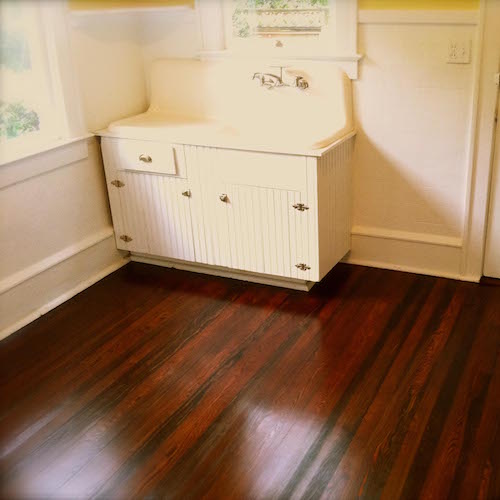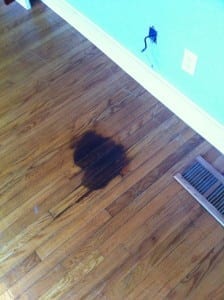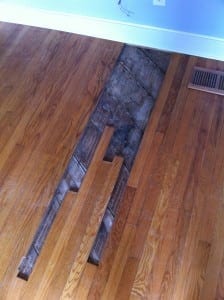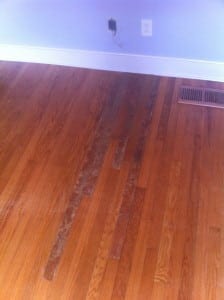 Hardwood floors are synonymous with old homes. It’s almost impossible to find an old home without them. And yet, they are disappearing because people don’t realize how resilient and long-lasting they are. Unknowing homeowners and contractors rip out or cover up these amazing floors when they could be saved and used for another 100+ years!
Hardwood floors are synonymous with old homes. It’s almost impossible to find an old home without them. And yet, they are disappearing because people don’t realize how resilient and long-lasting they are. Unknowing homeowners and contractors rip out or cover up these amazing floors when they could be saved and used for another 100+ years!
Other than refinishing hardwood floors, the most typical repair we run into is board replacement. It may seem daunting to remove a tongue and groove floor board without damaging the neighboring boards, but with a couple tricks of the trade I’ll teach you to get it done yourself if you are a brave DIY warrior.
And don’t miss my little secret to a perfect match at the end!
 Step #1 Remove the Damaged Boards
Step #1 Remove the Damaged Boards
Whether it’s termites or pet stains, some boards will inevitably be beyond saving. When you find these boards, you’ll have to remove them completely and find a suitable replacement (more on this later). It’s also important to take the entire board, or at least stagger the joints like in the picture below. This will allow the patch to blend in seamlessly with the existing floor. You’ll need a few tools to get the job done too:
-
- Circular Saw
- Hammer
- Cat’s Paw/Trim Pry Bar
- Wood Chisel
- Multi-Tool (recommended)
- Brad Nailer
- Mark the Boards – I mark the specific boards I will be removing very clearly along their entire length so there are no mistakes.
- Determine Thickness – You need to find out how thick they are (*this is important*). You need to know how thick the boards are so you can set the depth of the cut on your circular saw properly. Most old wood floors are between 1/2″ and 1″. The best place to find the depth is to remove a floor heat register or pull up a threshold. The threshold is less fun.
- Set Saw Depth – Once you know the thickness of your flooring, set your circular saw to just a hair deeper than the thickness of the flooring (about 1/32″).
- Cut 2 Lines – Make 2 parallel plunge cuts into the floor board along its length with the circular saw. Start and finish as close as you can to the ends without crossing into the next board. You’ll essentially be cutting the board into three slimmer boards. One piece will have the tongue, one piece the groove, and the middle piece will be free floating.
- Finish Cut With Multi-Tool – To finish the cut, you need a multi-tool or chisel. Cut the small amount of wood remaining to the end of the board so that all three pieces of the board are completely independent of each other.
- Remove the Pieces – The middle piece should come out easily with a pry bar or even your fingers. The groove side will likely need a bit more coaxing with your pry bar. The tongue side will have been nailed down and so you’ll need to use the cat’s paw to either dig out the nails or simply tear the remaining piece out. This side usually breaks a few times on its way out.
- Clean Up – Vacuum out all the saw dust and make sure the tongue and groove of the remaining boards are clear of any remaining wood and in good shape.
Step #2 Install the Replacement Boards
So, now that it’s all cleaned up and free of any damaged boards, you need to patch the floor with your replacement boards. If your replacement boards are not the EXACT same width and thickness as the originals, the repair will not work at all. Don’t think something close will suffice. Here is the way to get the boards into place properly.
- Measure & Cut to Length – Measure the length you need to replace and cut your replacement to size. It will need to be tight so if anything, don’t cut it short. Cut it long and sneak up on it if you must.
To replace just a few boards:
- Remove the Groove – You’ll need to remove the bottom half of the groove on your replacement board. I usually use a table saw to cut it off cleanly, but a wood chisel or hand plane will work fine. It doesn’t have to be pretty, just don’t hurt the top of the board. This is only to be done if you are replacing just a few boards. For larger sections see the instructions in the following section.
- Insert Tongue Side First – Insert the replacement piece tongue side first into the existing flooring. It will require some force to get it into place, but don’t be too aggressive. Sometime a piece of scrap lumber can be used as a beater board so you can gently hammer the piece in place with scarring the surface.
- Face Nail in Place – Once the board is seated properly and flush with the existing floor, you can nail it in place. I put two 1 1/2″ brads on each end and then every 16-24″ alternating sides. Keep in mind that since we removed the bottom half of the groove, the only thing holding that side down in the nail. So you may need a couple more nails on the groove side if the board isn’t perfectly snugged down at first.
To replace a large section:
- Insert Groove Side First – If you’re doing a large section, you should install the groove side first. There is no need to remove the groove. Simply fit the replacement’s groove into the existing board’s tongue. Use a beater board and hammer to make sure it is fully seated and snug.
- Blind Nail – With this technique you can now blind nail the board in place by nailing through the tongue into the subfloor or floor joist. Do this every 16″ or every where you have a joist if there is no subfloor.
- The Last Board – In order the set the final board, you will have to follow the instructions above about removing the groove. and continue on from there.
Step #3 Refinish the Repair
Once the boards are in place, the only way to have a seamless match is to refinish the whole floor. This will take care of any high or low spots and will also ensure a consistent finish throughout.
If you replaced just a couple boards, you may be able to finish them prior to installing, but they will still look slightly different. If a full refinishing is beyond your reach or price range right now then just relax. The replacement boards will be fine until the time to refinish works with your budget. Until then, you’ll just have to enjoy the fact that you don’t have crumbling or badly stained boards anymore!
A Few More Tips
Now you have the basics for replacing damaged boards on your hardwood floors. It has always been a fairly easy repair for me to do, but as I wrote the instructions down, I began to realize how much there was to think about! It really is fairly straight forward, I promise.
You may just want to print out this list to set beside you if you decide to take this on. I’ll also be putting together a video very soon of the process for those of you who are visual learners like me! But here’s a few more things to think about before you start:
-
- Get the same species of wood – This kind of goes without saying, but you need replacement boards of the same species of wood, otherwise they won’t match. The 3 types of historic flooring I run across the most often are heart pine, red oak, and white oak.
- Get the same age of floors – This is my little secret to make your floors match PERFECTLY! Wood has changed a lot over the decades and centuries. If you put red oak from 1995 next to red oak from 1925, next to red oak from 1795, all three will look very different. Try to find replacement boards from the same decade from architectural salvage.
- Subfloor or not – Some old houses have subfloors and some do not. If you start taking up boards and don’t find a subfloor, don’t panic. It is more difficult, but can be done just the same. Your replacement boards will just have to end and start on a floor joist. Also, be careful not to fall through!
Alright, that’s it! You now know pretty much everything I know about hardwood flooring repair from this VERY long post. Now go get busy saving that old house!
Photos: © Austin Home Restorations

Founder & Editor-in-Chief
I love old houses, working with my hands, and teaching others the excitment of doing it yourself! Everything is teachable if you only give it the chance.



I’m now living in my husband’s childhood home and when they had the stairs moved over, the men who did it, just put down a piece of plywood instead of using extra boards. Where do I start???
Will this process help repair unevem floors?
Thank you for your question. Please take a look at Scott’s Patreon Page https://www.patreon.com/thecraftsmanblog. You can choose from a membership that suits your needs to gain access to answers to questions related to your specific projects.
The Craftsman Blog Team
This is the first article I’ve found that addresses the repair of hardwood floors and I’m glad I came across it.
The tips are very helpful and I can finally start on renovation that I’ve been putting off.
Thanks a lot.
On repairing several floor boards which do i start with ? Tongue or the groove?
Informative and interesting Blog! Beautifully written, as usual, I like the post. Thank you so much for nice sharing with us. Keep posting!